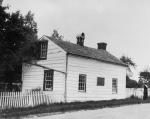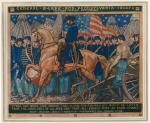![header=[Marker Text] body=[Gen. George G. Meade, who had replaced Hooker as Union commander, June 28, 1863, traveled this road from Taneytown to Gettysburg the night of July 1. He made his headquarters just south of Gettysburg.] sign](http://explorepahistory.com/kora/files/1/10/1-A-1FF-139-ExplorePAHistory-a0h2r2-a_450.jpg)
Mouse over for marker text
Name:
Gettysburg Campaign [Meade's arrival]
Region:
Hershey/Gettysburg/Dutch Country Region
County:
Adams
Marker Location:
Pennsylvania Route 134, .7 mile north of state line
Dedication Date:
December 12, 1947
Behind the Marker
 George G. Meade took command of the Army of the Potomac only three days before the opening salvos at the battle of Gettysburg. Given a command he did not seek, Meade handled the sudden responsibility in a competent manner.
George G. Meade took command of the Army of the Potomac only three days before the opening salvos at the battle of Gettysburg. Given a command he did not seek, Meade handled the sudden responsibility in a competent manner.
Meade's first act was to move his seven infantry corps and the cavalry north from the Frederick, Maryland, area to find General Robert E. Lee's army in Pennsylvania. Lee, whose own cavalry was largely ineffective during the campaign, did not learn of the Yankee army's approach until the night of June 28, when one of James Longstreet's spies reported to Lee's headquarters in Messersmith's Woods near Chambersburg. Lee did not yet know, however, that Meade had taken command, in spite of several claims otherwise.
Messersmith's Woods near Chambersburg. Lee did not yet know, however, that Meade had taken command, in spite of several claims otherwise.
Meade's movements of the Union army forced Lee to concentrate his troops at Cashtown, west of Gettysburg. Realizing his deployments had forced Lee to concentrate, Meade's orders for July 1 instructed his generals where to place their corps, moving cautiously because Meade did not yet know exactly where Lee's troops were located.
Meade had originally wanted to force Lee to attack his army in the area of Pipe Creek, Maryland. But when he learned of the fighting at Gettysburg and the death of John F. Reynolds, Meade sent his Second Corps commander,
John F. Reynolds, Meade sent his Second Corps commander,  Winfield S. Hancock to Gettysburg to assess the situation. Even before receiving Hancock's favorable report, Meade ordered all his units to march to Gettysburg.
Winfield S. Hancock to Gettysburg to assess the situation. Even before receiving Hancock's favorable report, Meade ordered all his units to march to Gettysburg.
Meade himself arrived at Gettysburg shortly after midnight on July 1. After speaking with his subordinates at the Evergreen Cemetery gatehouse, he gave orders for his army's deployment, and located his headquarters in a small farmhouse next to the Taneytown Road.
The general at first wanted to attack the Rebels on July 2, but reconnaissance reports induced Meade to remain on the defensive and await the arrival of all his troops. Even when his Third Corps commander, Daniel E. Sickles, disobeyed orders and took his corps out of line, Meade rose to the occasion by dispatching reinforcements to his left flank; after four hours of hard fighting, the Yankee line remained on high ground. He also correctly guessed that Lee would assail the Union center on July 3.
Only after Lee's retreat from Gettysburg did the criticism of Meade's generalship begin. A few days after the battle, the wounded Dan Sickles regaled President Lincoln with his own view of the battle, informing the president that Meade had little to do with the victory. And when Lee's army managed to retreat across the Potomac River, Lincoln was badly disappointed.
Stung by the criticism, Meade offered his resignation. Lincoln refused to accept it, and then learned more of the battle through Oliver O. Howard and other officers, who vouched for Meade's wise handling of the army.
Meade's trials, however, were far from over. In February 1864, the Joint Congressional Committee on the Conduct of the War began hearings on Gettysburg. Using disgruntled officers such as Sickles and Alfred Pleasonton to blacken Meade's reputation, the committee tried to have Meade replaced by someone more favorable to their radical Republican politics. But Lincoln refused to be swayed by the partisan attack. When Ulysses S. Grant became the new general-in-chief in March 1864, he also retained Meade as commander of the Army of the Potomac.
Thus, Meade acquired the reputation of being a mediocre general who got lucky at Gettysburg because of the heroic actions of his subordinates. The subject of only three full-length biographies–a low number when compared to the number of works written on other Civil War Generals of his prominence, recent scholarship on Gettysburg has provided a more balanced view of the general's role at Gettysburg and indeed in the campaigns of 1864-1865.
Meade's first act was to move his seven infantry corps and the cavalry north from the Frederick, Maryland, area to find General Robert E. Lee's army in Pennsylvania. Lee, whose own cavalry was largely ineffective during the campaign, did not learn of the Yankee army's approach until the night of June 28, when one of James Longstreet's spies reported to Lee's headquarters in
Meade's movements of the Union army forced Lee to concentrate his troops at Cashtown, west of Gettysburg. Realizing his deployments had forced Lee to concentrate, Meade's orders for July 1 instructed his generals where to place their corps, moving cautiously because Meade did not yet know exactly where Lee's troops were located.
Meade had originally wanted to force Lee to attack his army in the area of Pipe Creek, Maryland. But when he learned of the fighting at Gettysburg and the death of
Meade himself arrived at Gettysburg shortly after midnight on July 1. After speaking with his subordinates at the Evergreen Cemetery gatehouse, he gave orders for his army's deployment, and located his headquarters in a small farmhouse next to the Taneytown Road.
The general at first wanted to attack the Rebels on July 2, but reconnaissance reports induced Meade to remain on the defensive and await the arrival of all his troops. Even when his Third Corps commander, Daniel E. Sickles, disobeyed orders and took his corps out of line, Meade rose to the occasion by dispatching reinforcements to his left flank; after four hours of hard fighting, the Yankee line remained on high ground. He also correctly guessed that Lee would assail the Union center on July 3.
Only after Lee's retreat from Gettysburg did the criticism of Meade's generalship begin. A few days after the battle, the wounded Dan Sickles regaled President Lincoln with his own view of the battle, informing the president that Meade had little to do with the victory. And when Lee's army managed to retreat across the Potomac River, Lincoln was badly disappointed.
Stung by the criticism, Meade offered his resignation. Lincoln refused to accept it, and then learned more of the battle through Oliver O. Howard and other officers, who vouched for Meade's wise handling of the army.
Meade's trials, however, were far from over. In February 1864, the Joint Congressional Committee on the Conduct of the War began hearings on Gettysburg. Using disgruntled officers such as Sickles and Alfred Pleasonton to blacken Meade's reputation, the committee tried to have Meade replaced by someone more favorable to their radical Republican politics. But Lincoln refused to be swayed by the partisan attack. When Ulysses S. Grant became the new general-in-chief in March 1864, he also retained Meade as commander of the Army of the Potomac.
Thus, Meade acquired the reputation of being a mediocre general who got lucky at Gettysburg because of the heroic actions of his subordinates. The subject of only three full-length biographies–a low number when compared to the number of works written on other Civil War Generals of his prominence, recent scholarship on Gettysburg has provided a more balanced view of the general's role at Gettysburg and indeed in the campaigns of 1864-1865.







